uh-1n: นี่คือโพสต์ที่เกี่ยวข้องกับหัวข้อนี้




























search Skytamer.com





























Bell UH-1N Iroquois (Huey)
United States — Six-seat Utility Helicopter
Archive Photos 1,3
[Bell UH-1N Iroquois (BuNo 158276) at the 1988 MCAS El Toro Airshow]

[Bell UH-1N Iroquois (BuNo 158544) at the 2003 MCAS Miramar Air Show, San Diego, CA]

Overview 2
The Bell Helicopter UH-1 “Iroquois”, commonly (or officially in the U.S. Marine Corps) known as the “Huey,” is a multipurpose military helicopter, famous for its use in the Vietnam War. The Bell UH-1 “Iroquois” was developed from 1955 US Army trials with the Bell Model 204. The initial designation of HU-1 (helicopter utility) led to its nickname, “Huey.” The aircraft was first used by the military in 1959 and went into tri-service production in 1962 as the Bell UH-1 “Iroquois”. The last were produced in 1976 with more than 16,000 made in total, of which about 7,000 saw use during the Vietnam War. In Vietnam, 2,202 “Huey” pilots were killed and approximately 2,500 aircraft were lost, roughly half to combat and the rest to operational accidents.
- U.S. Army Bell UH-1D Iroquois
- Role: Multipurpose utility helicopter
- Manufacturer: Bell Helicopter
- First flight: 22 October 1956 (XH-40)
- Introduction: 1959
- Primary users: United States Army, Japan Ground Self-Defense Force, Royal Australian Air Force (RAAF), Armed Forces of the Philippines
- Number built: more than 16,000
- Variants: UH-1N Twin Huey, AH-1 Cobra, Bell 204/205, Bell 212, Bell 214
Design and Development 2
Earlier helicopters had been powered by piston engines. By the early 1950s, however, turbine engines were being used in many fixed-wing aircraft and aircraft designers began to consider using them for rotary-wing use. Turbines, though expensive to build, were long-lived, durable, and extremely light for their power output in comparison to piston-powered engines.
The first Bell helicopter to use a turbine engine was a modified Model 47 (designated the XH-13F), first flown in October 1954. In 1955, anxious to obtain a powerful medical evacuation helicopter, the U.S. Army awarded Bell a contract to develop the next generation turbine-powered helicopter, designated the XH-40 (Bell company designation was the Model 204). The first XH-40 flew on 22 October 1956. Two more prototypes were built in 1957, and six YH-40 prototypes were tested in 1958.
Bell believed the YH-40 was ideal for troop transport and cargo carrying as well as the medevac role, a view soon adopted by the Army, who found the pre-production aircraft so much better in service than previous piston-powered helicopters they soon ordered more of them.
The HU-1A (later redesignated the UH-1A) was the first turbine-equipped U.S. helicopter to go into production, and production models first entered service with the 101st Airborne Division at Fort Campbell, Kentucky, the 82nd Airborne Division and the 57th Medical Detachment. Although they were intended for evaluation only, the Army quickly pressed them into operational service and Hueys with the 57th Medical Detachment arrived in Vietnam in March 1962.
The helicopter was originally designated the HU-1A, which is where it received its nickname “Huey,” a reference so popular that Bell started putting the Huey name on the anti-torque pedals. The official U.S. Army designation “Iroquois” (Army helicopters are traditionally given Native American names) was almost never used in practice.
Aircraft Markings 2
Bell UH-1Hs used for ferrying VIP’s into Panmunjom in the DMZ area between North and South Korea used three 12″ wide Yellow stripes vertically over the fuselage. It signified unarmed aircraft carrying UNCMAC members.
U.S. Navy UH-1Ns serving as “organic to the ship” helicopters on LPH and LHA amphibious war vessels were painted dark grey with national insignia, much like the paint scheme carried on the Kaman SH-2 “Seasprite” throughout the 1980s. Each ship had one helicopter, and the ship’s name was often carried on the cabin doors.
Operational History 2
Service in Vietnam
The Bell UH-1 has long become a symbol of US involvement in Southeast Asia in general and Vietnam in particular, and as a result of that conflict, has become one of the world’s most recognized helicopters. In Vietnam primary missions included general support, air assault, cargo transport, aeromedical evacuation, search and rescue, electronic warfare, and later, ground attack. During the conflict, the craft was upgraded, notably to a larger version based on the Model 205. This version was initially designated the UH-1D and flew operationally from 1963.
Helicopters played an integral part in the U.S military’s land and air operations. Here UH-1D’s airlift members of the 2nd Battalion, 14th Infantry Regiment from the Filhol Rubber Plantation area to a new staging area, in 1966. During service in the Vietnam War, the UH-1 was used for various purposes and various terms for each task abounded. UH-1s tasked with a ground attack or armed escort role were outfitted with rocket launchers, grenade launchers, and machine guns. These gunship UH-1s were commonly referred to as “Hogs” if they carried rockets, and “Cobras” if they had guns. UH-1s tasked for troop transport were often called Slicks due to an absence of weapons pods. Slicks did have door gunners, but were generally employed in the troop transport and medevac roles. In the US Navy and USMC the gunships were referred to as “Sharks” and troop transport aircraft as “Dolphins”.
Bell UH-1s also flew hunter-killer teams with observation helicopters, namely the Bell OH-58A “Kiowa” and the Hughes OH-6 “Cayuse”. Towards the end of the conflict, the UH-1 was tested with TOW missiles, and two UH-1B helicopters equipped with the XM26 Armament Subsystem were deployed to help counter the 1972 Easter Invasion.
Bell UH-1 troop transports were designated by “Blue” teams, hence the nickname for troops carried in by these “Hueys” as the “Blues”. The reconnaissance or observation teams were “White” teams. The attack ships were called “Red” teams. Over the duration of the conflict the tactics used by the military evolved and teams were mixed for more effective results. “Purple” teams with one or two “Blue” slicks dropping off the troops, while a “Red” attack team provided protection until the troops could defend themselves. Another highly effective team was the “Pink Recon/Attack” team, which offered the capability of carrying out assaults upon areas where the enemy was known to be present but could not be pinpointed.
During the course of the war, the UH-1 went through several upgrades. The UH-1A, UH-1B, and UH-1C models (short fuselage, Bell 204) and the UH-1D and UH-1H models (stretched-fuselage, Bell 205) each had improved performance and load-carrying capabilities. The UH-1B and UH-1C performed the gunship and some of the transport duties until 1967, when the new AH-1 “Cobra” arrived on the scene. The newer “Cobra”, a purpose-built attack helicopter based on the UH-1 was faster, sleeker, harder to hit, and could carry more ordnance. The increasing intensity and sophistication of NVA anti-aircraft defenses made continued use of gunships based on the UH-1 impractical, and after Vietnam the “Cobra” was adopted as the Army’s main attack helicopter. Devotees of the UH-1 in the gunship role cite its ability to act as an impromptu dustoff if the need arose, as well as the superior observational capabilities of the larger “Huey” cockpit, which allowed return fire from door gunners to the rear and sides of the aircraft.
During the war 3,305 UH-1s were destroyed. In total, 5,086 helicopters were destroyed out of 11,827 documented in service.
USAF
In October 1965, the USAF 20th Special Operations Squadron was formed at Tan Son Nhut Air Base in South Vietnam, equipped initially with Sikorsky CH-3C helicopters. By June 1967 the UH-1F and UH-1P were also added to the unit’s inventory, and by the end of the year the entire unit had shifted from Tan Son Nhut to Nakhon Phanom Royal Thai Air Force Base. On 1 August 1968, the unit was redesignated the 20th Special Operations Squadron. The 20th’s UH-1s were known as the “Green Hornets”, stemming from their color, a primarily green two-tone camouflage (green and tan) was carried, and radio call-sign “hornet”. The main role of these helicopters were to insert and extract reconnaissance teams, provide cover for such operations, conduct psychological warfare, and other support roles for covert operations especially in Laos during the so-called Secret War.
El Salvador
During its civil war El Salvador received about 80 UH-1Hs and 24 UH-1Ms from the US, as part of the aid to fight the guerrillas between 1979 and 1992. These helicopters were heavily engaged in combat, supporting the army in fighting guerrillas throughout the country. As a result many were shot down. After the war only 20 UH-1H and 14 UH-1M survived, most of them scrapped a few years later.
These helicopters were operated by El Salvador Air Force, being at its time the biggest and most experienced combat helicopter force in Central and South America, fighting during 10 years and being trained by US Army in tactics developed during the Vietnam war. Gunship UH-1M helicopters used by El Salvador were modified to carry bombs instead of rocket pods. UH-1Hs were also used as improvised bombers.
During the battle of Nahr el-Bared camp in North Lebanon, the Lebanese army, lacking fixed-wing aircraft, modified the UH-1H allowing it to carry 500 lb (227 kg) Mk. 82 dumb bombs to strike militant positions. Each Huey was equipped on each side with special mounts engineered by the Lebanese army, to carry the high explosive bombs.
Current service
The US Army phased out the UH-1 Huey with the introduction of the UH-60 “Black Hawk”, although the Army UH-1 Residual Fleet has around 700 UH-1s that were supposed to be retained until 2015. Army support for the craft was intended to end in 2004.
The US Marine Corps still relies on the UH-1N variant and is beginning to introduce the latest variant, the UH-1Y “Venom”.
The United States Air Force employs UH-1N “Hueys” to fulfill its ICBM mission, providing a utility helicopter for transport between bases such as Francis E. Warren AFB and Malmstrom AFB to missile launch sites in Montana, Wyoming, Nebraska, and Colorado. Additionally, the UH-1N is used by the 36th Rescue Flight (36 RQF) at Fairchild AFB, near Spokane, WA for conducting Search-and-Rescue (SAR) and medical evacuation missions.
The UH-1 has been widely exported and remains in front line service in a number of countries.
Variant Overview 2
U.S. Military Variants
- XH-40: The initial Bell 204 prototype. Three prototypes were built, equipped with the Lycoming XT-53-L-1 engine of 700 shp.
- YH-40: Six aircraft for evaluation, as XH-40 with 12-inch cabin stretch and other modifications.
- Bell Model 533: One YH-40BF rebuilt as a flight test bed with turbofan engines and wings.
- HU-1A: Initial Bell 204 production model, redesignated as the UH-1A in 1962. 182 built.
- TH-1A: UH-1A with dual controls and blind-flying instruments, 14 conversions.
- XH-1A: A single UH-1A was redesignated for grenade launcher testing in 1960.
- HU-1B: Upgraded HU-1A, various external and rotor improvements. Redesignated UH-1B in 1962. 1014 built plus four prototypes designated YUH-1B.
- NUH-1B: a single test aircraft, serial number 64-18261.
- UH-1C: UH-1B with improved engine, modified blades and rotor-head for better performance in the gunship role. 767 built.
- YUH-1D: Seven pre-production prototypes of the UH-1D.
- UH-1D: Initial Bell 205 production model (long fuselage version of the 204). Designed as a troop carrier to replace the CH-34 then in US Army service. 2008 built many later converted to UH-1H standard.
- HH-1D: Army crash rescue variant of UH-1D.
- UH-1E: UH-1B/C for USMC with different avionics and equipment. 192 built.
- NUH-1E: UH-1E configured for testing.
- TH-1E: UH-1C configured for Marine Corps training. Twenty were built in 1965.
- UH-1F: UH-1B/C for USAF with General Electric T-58-GE-3 engine of 1,325 shp. 120 built.
- TH-1F: Instrument and Rescue Trainer based on the UH-1F for the USAF. 26 built.
- UH-1H: Improved UH-1D with a Lycoming T-53-L-13 engine of 1,400 shp. 5435 built.
- CUH-1H: Canadian Forces designation for the UH-1H utility transport helicopter. Redesignated CH-118. 10 built.
- EH-1H: Twenty-two aircraft converted by installation of AN/ARQ-33 radio intercept and jamming equipment for Project Quick Fix.
- HH-1H: SAR variant for the USAF with rescue hoist. 30 built.
- JUH-1: Five UH-1Hs converted to SOTAS battlefield surveillance configuration with belly-mounted airborne radar.
- TH-1H: Recently modified UH-1Hs for use as basic helicopter flight trainers by the USAF.
- UH-1G: Unofficial name applied locally to at least one armed UH-1H by Cambodia.
- UH-1J: An improved Japanese version of the UH-1H built under license in Japan by Fuji was locally given the designation UH-1J. Among improvements were an Allison T53-L-703 turboshaft engine providing 1,343 kW (1,800 shp), a vibration-reduction system, infrared countermeasures, and a night-vision-goggle (NVG) compatible cockpit.
- HH-1K: Purpose built SAR variant of the Model 204 for the US Navy with USN avionics and equipment. 27 built.
- TH-1L: Helicopter flight trainer based on the HH-1K for the USN. Forty-five were built.
- UH-1L: Utility variant of the TH-1L. Eight were built.
- UH-1M: Gunship specific UH-1C upgrade with Lycoming T-53-L-13 engine of 1,400 shp.
- UH-1N: Initial Bell 212 production model, the Bell “Twin Pac” twin-engined Huey.
- UH-1P: UH-1F variant for USAF for special operations use and attack operations used solely by the USAF 20th Special Operations Squadron, “the Green Hornets”.
- EH-1U: No more than 2 UH-1H aircraft modified for Multiple Target Electronic Warfare System (MULTEWS).
- UH-1V: Aeromedical evacuation, rescue version for the US Army.
- EH-1X: Ten Electronic warfare UH-1Hs converted under “Quick Fix IIA”.
- UH-1Y: Upgraded variant developed from existing upgraded late model UH-1Ns, with additional emphasis on commonality with the AH-1Z.
- Note: In U.S. service the G, J, Q, R, S, T, W and Z model designations are used by the AH-1. The UH-1 and AH-1 are considered members of the same H-1 series. The military does not use I (India) or O (Oscar) for aircraft designations to avoid confusion with “one” and “zero” respectively.
Other Military Variants
- Bell 204: Bell Helicopters company designation, covering aircraft from the XH-40, YH-40 prototypes to the UH-1A, UH-1B, UH-1C, UH-1E, UH-1F, HH-1K, UH-1L, UH-1P and UH-1M production aircraft.
- Agusta-Bell AB 204: Military utility transport helicopter. Built under license in Italy by Agusta.
- Agusta-Bell AB 204AS: Anti-submarine warfare, anti-shipping version of the AB 204 helicopter.
- Fuji-Bell 204B-2: Military utility transport helicopter. Built under license in Japan by Fuji Heavy Industries. Used by the Japan Ground Self-Defense Force under the name “Hiyodori”.
- Bell 205: Bell Helicopters company designation of the UH-1D and UH-1H helicopters.
- Bell 205A-1: Military utility transport helicopter version, initial version based on the UH-1H.
- Bell 205A-1A: As 205A-1, but with armament hardpoints and military avionics. Produced specifically for Israeli contract.
- Agusta-Bell 205: Military utility transport helicopter. Built under license in Italy by Agusta.
- AIDC UH-1H: Military utility transport helicopter. Built under license in Taiwan by Aerospace Industrial Development Corporation.
- Dornier UH-1D: Military utility transport helicopter. Built under license in Germany by Dornier Flugzeugwerke.
- Fuji-Bell 205A-1: Military utility transport helicopter. Built under licence in Japan by Fuji. Used by the Japanese Ground Self Defence Force under the designation HU-1H.
- Bell Huey II: A modified and re-engined UH-1H, significantly upgrading its performance, and its cost-effectiveness. Currently offered by Bell to all current military users of the type.
- UH-1/T700 Ultra Huey: Upgraded commercial version, fitted with a 1,400-kW (1900-shp) General Electric T700-GE-701C turboshaft engine.
List of UH-1 Iroquois Operators 2
- Afghanistan
- Albania
- Argentina
- Australia
- Austria
- Bahrain
- Bangladesh
- Belize
- Bolivia
- Bosnia and Herzegovina
- Brazil
- Brunei
- Burma
- Cambodia
- Canada
- Chile
- Colombia
- Costa Rica
- Dominican Republic
- El Salvador
- Ecuador
- Ethiopia
- Germany
- Greece
- Georgia
- Guatemala
- Honduras
- Indonesia
- Iran
- Iraq
- Israel
- Italy
- Jamaica
- Japan:
- Jordan
- Kuwait
- Lebanon
- Macedonia
- Mexico
- Morocco
- Netherlands
- New Zealand
- Norway
- Oman
- Pakistan
- Panama
- Paraguay
- Papua New Guinea
- Peru
- Philippines
- Republic of China (Taiwan)
- Rhodesia
- Saudi Arabia
- Senegal
- Singapore
- Serbia
- Somalia
- South Korea
- South Vietnam
- Spain
- Sweden
- Tanzania
- Thailand
- Tunisia
- Turkey
- Uganda
- United Arab Emirates
- United States
- Uruguay
- Venezuela
- Vietnam
- Yemen
- Zambia
- Zimbabwe
Specifications (UH-1D) 2
General Characteristics
- Crew: 1-4
- Capacity: 3,880 lb including 14 troops, or 6 stretchers, or equivalent cargo
- Length: 57 ft 1 in with rotors (17.4 m)
- Fuselage width: 8 ft 7 in (2.6 m)
- Rotor diameter: 48 ft 0 in (14.6 m)
- Height: 14 ft 5 in (4.4 m)
- Empty weight: 5,215 lb (2,365 kg)
- Loaded weight: 9,040 lb (4,100 kg)
- Max takeoff weight: 9,500 lb (4,310 kg)
- Powerplant: 1 × Lycoming T53-L-11 turboshaft, 1,100 shp (820 kW)
Performance
- Maximum speed: 135 mph (220 km/h)
- Cruise speed: 125 mph (205 km/h)
- Range: 315 mi (510 km)
- Service ceiling: 19,390 ft (Dependent on environmental factors such as weight, outside temp., etc) (5,910 m)
- Rate of climb: 1,755 ft/min (8.9 m/s)
- Power/mass: 0.15 hp/lb (0.25 kW/kg)
Armament (Variable, but may include a combination of:)
- 2 × 7.62 mm M60 machine gun, or 2 × 7.62 mm GAU-17/A machine gun
- 2 × 7-round or 19-round 2.75 in (70 mm) rocket pods
- 2 × 7.62 mm Rheinmetall MG3 (German Army and German Luftwaffe)
Popular Culture 2
The image of American troops disembarking from a “Huey” has become iconic of the Vietnam War, and can be seen in many films, video games and television shows on the subject, as well as more modern settings. The Bell UH-1 “Huey” is seen in many films about the Vietnam war, including The “Green Berets”, “Platoon”, “Hamburger Hill”, “Apocalypse Now”, “Casualties of War”, and “Born on the Fourth of July”. It is prominently featured in “We Were Soldiers” as the main helicopter used by the U.S. Cavalry in the Battle of Ia Drang.
References
- Shupek, John. Photos via , copyright © 2001, 2005 Skytamer Images. All Rights Reserved
- Wikipedia, Bell UH-1 Iroquois
- AFIA (Lt. Col. Dr. Marc Matthews, M.D., USAF (retired). Photos by AFIA copyright © 11/11/2011
Copyright © 1998-2020 (Our 22nd Year) Skytamer Images, Whittier, California
ALL RIGHTS RESERVED
Table of Contents
[Update] UH-1 이로쿼이 헬리콥터 | uh-1n – Australia.xemloibaihat
무기백과
UH-1 이로쿼이 헬리콥터
공중기동의 개념을 탄생시킨 베트남 전쟁의 아이콘
- 중화민국(타이완) 육군용 UH-1H 이로쿼이 일러스트. (삽화: 알파캣)
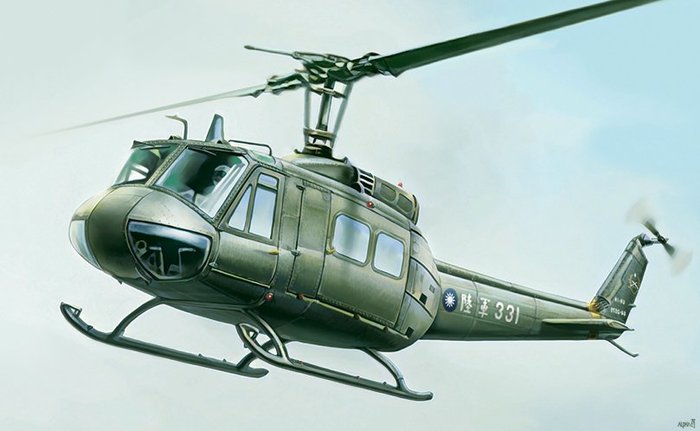
개발의 역사
6·25전쟁이 한창이던 1952년, 미 육군은 의무후송(Medical Evacuation/MEDIEVAC)과 계기비행 훈련을 비롯한 다목적 용도로 벨(Bell)사의 H-13 수우(Sioux) 헬리콥터를 운용했으나, H-13은 동체가 지나치게 크고 출력이 약한 데다 유지 보수가 복잡하여 운용이 쉽지 않았다. 하지만 H-13은 전장에서 헬기의 유용성을 증명했기 때문에 미 육군은 이를 대체할 대체 기종 도입의 필요성을 느낄 수밖에 없었다. 특히 미 육군은 6·25전쟁 간 병사 100명 당 사상자 비율이 2.5명에 달했던 만큼 가장 대체 헬기의 도입을 뼈저리게 느꼈으며, 그중에서도 미 육군 의무병과단에서 응급 의무후송용 항공 자산을 필요로 했다. 최초에는 의무병과의 소요 제기에 따라 1952년에 대체 헬기 요구도가 작성되어 올라갔으나, 1953년 11월에는 미 육군본부 차원에서 대체 헬기의 필요성이 제기됨에 따라 앞서 발행한 요구도가 개정되었다. 미 육군은 1952년부터 터빈 동력 방식을 사용하여 항속 거리와 탑재 중량을 증가시킨 헬기 요구도로 수정했으며, 이 기체를 주로 환자후송용(MEDIEVAC: Medical Evacuation) 및 병력 물자 수송 용도로 활용할 계획을 수립했다. 이 입찰에는 모델(Model) 204형을 제출한 벨 헬리콥터(Bell Helicopter) 외에도 H-43 헬리콥터에 터빈 엔진을 장착시킨 형상을 제출한 카만(Kaman) 항공 등 20여 개 업체가 참여했지만, 결국 미 육군은 1955년 2월 23일 자로 벨사를 우선협상대상자로 선정한 후 모델 204 세 대 납품 계약을 체결하면서 해당 기체를 XH-40으로 명명했다.
- H-13 수우 헬기를 교체하기 위해 벨 사가 제시한 모델 204 (출처: Public Domain)
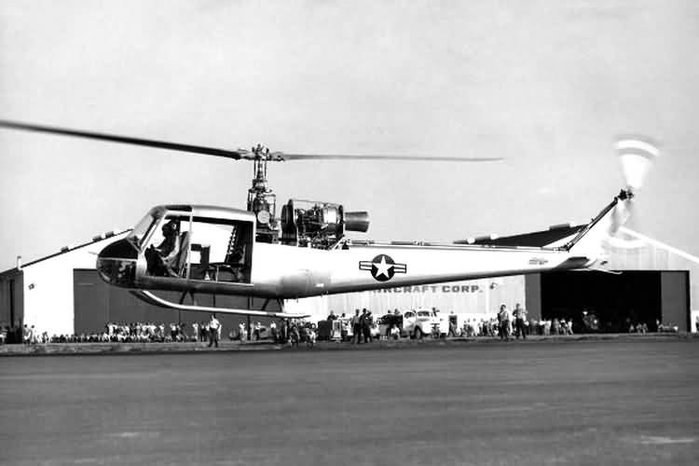
벨사는 1956년 1월 20일 자로 XH-40에 펜실베이니아 주 소재 엔진 제조업체인 라이커밍 엔진사(Lycoming, 1985년 텍스트론이 인수하여 계열화)의 700마력급 YT53-L-1 엔진을 장착하여 텍사스주 포트워스(Fort Worth, TX)에서 시험 비행에 성공했으며, 1957년에 시제기 2, 3번기를 출고했다. 그 사이에 주문 수량을 6대로 늘린 미 육군은 1960년 3월 자로 벨사와 총 100대의 헬기에 대한 양산 계약을 체결하여 최초의 시제기인 HU-1의 개발이 시작됐다. 이후에도 비공식적으로 UH-1 시리즈는 계속 “휴이”라는 비공식 별칭으로 불리게 되는데, 이는 시제기 제식 번호가 HU-1인 것에 착안하여 HU를 애칭으로 부른 것이다. 이 명칭은 1962년 미 육, 해, 공군이 모여 무기 체계 제식 번호를 정리한 3군 통합 제식 번호 명령 체계 재정리(Unified Tri-service Designation)에 따라 UH-1으로 변경되었으나 “휴이”라는 별명은 그대로 남았다. UH-1 헬리콥터에는 인디언 부족 이름을 붙여온 미군 전통에 따라 미국 독립전쟁 시기 북아메리카의 서북 지역 인디언 원주민 연합체 이름이던 “이로쿼이(Iroquois)”를 정식 이름으로 지정했다. 이로쿼이 부족은 6개 부족(모호크, 오노다가, 오네이다, 카유가, 세네카, 투스카로라)으로 구성된 연맹체로 모두 이로쿼이 계통 언어를 쓰던 부족의 집단 연맹이었다.
- UH-1에 앞선 YH-40 시제헬기 (출처: UNT Digital Library Collections)

UH-1 시리즈는 기존 피스톤 엔진 방식의 헬기보다 성능이 월등했으므로 군으로부터 높은 평가를 받았으나, 정작 운용 군인 미 육군은 YH-40의 출력이 부족하다고 판단했기 때문에 770마력 T53-L-1A 엔진을 쓴 UH-1A형의 개선이나 개량을 요구했다. 이에 벨사는 라이커밍의 960마력급 T53-L-5 엔진을 장착한 UH-1B형을 개발했으며, B형은 캐빈 공간과 동체 크기를 늘렸기 때문에 총 7명이 탑승하거나 4개의 들것을 넣을 수 있게 되었다. 이 B형은 1960년 11월부터 양산에 들어가 1961년 3월부터 인도가 시작됐다. 미 육군은 UH-1B형을 무장시켜 “건십(Gunship)” 개념으로도 활용했는데, 무장을 장착한 B형에서 항공역학 상의 문제가 발견되자 벨에서는 이를 개선한 UH-1C형을 1960년부터 개발했다. UH-1C는 특히 무장을 장착한 상태에서도 비행 속도를 올리고, 긴급 하강 시 후퇴깃 실속 현상(retreating blade stall)이 발생하는 것을 막기 위해 새로운 로터 작동 체계가 채택됐다.
- UH-1C부터는 새로운 로터 방식을 채용하여 긴급 하강시 후퇴깃 실속현상을 막을 수 있었다. (출처: Public Domain)
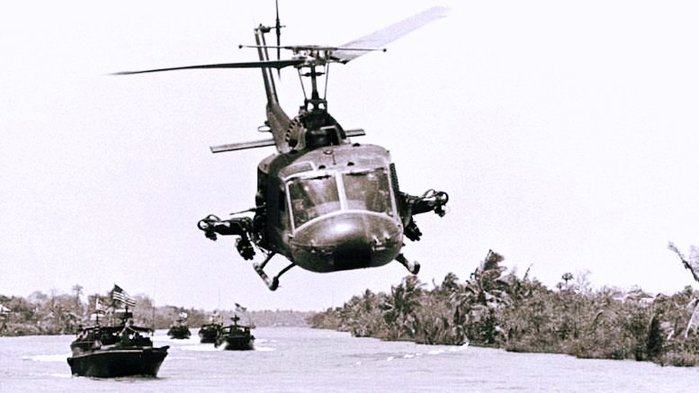
한편 미 육군은 탑재 중량을 증가하여 더 많은 인원을 탑승시킬 수 있는 UH-1의 개발을 원했고, 이에 따라 벨은 1B형의 동체를 약 104cm 가량 늘려 동체 바깥을 향하는 방향으로 4개의 좌석을 더 추가할 수 있도록 해 총 탑승 인원을 15명까지 늘렸다. 이 공간에는 6개의 들것이 들어갈 수 있었으므로 의무후송용으로도 적합했으며, 후방 도어의 유리창도 두 개로 늘린 데다 경첩 방식으로 설계하여 급할 경우 도어를 제거하고 비행하기 쉽도록 설계했다. 해당 형상은 ‘모델 205’라 명명되어 1961년 8월 16일에 초도 비행을 실시했으며, 7대의 사전 양산기와 시제기가 개발되어 1961년 3월부터 시험평가를 실시했다. 미 육군은 1963년부터 모델 205 양산 계약을 체결하면서 T53-L-11 엔진 장착을 주문하였고, 이에 따라 모델 205는 양산 단계로 넘어가면서 UH-1D로 명칭이 변경됐다. 미 육군은 3년 뒤인 1966년 동일 형상에 엔진을 1,400마력급 T53-L-13 엔진으로 교환하면서 제식 번호를 UH-1H로 지정했다.
- UH-1B의 동체를 확장한 UH-1D는 최대 15명을 탑승시킬 수 있었다. (출처: SFC James K. F. Dung / US Army)

한편 미 해병대도 1962년부터 기존에 운용하던 세스나(Cessna) O-1 버드 독(Bird Dog) 고정익 항공기와 카만의 OH-43D 허스키(Huskie) 헬리콥터를 대체하기 위해 입찰을 진행했으며, 평가 결과 이미 미 육군이 채택하여 실전 배치에 들어간 UH-1B를 선택했다. 하지만 해병대는 육군과 다른 요구도를 제시했기 때문에 이를 맞춘 기체에 UH-1E를 제식 번호로 지정했다. UH-1E형은 1963년 10월 7일에 초도 비행을 실시한 후 1964년 2월부터 해병대에 총 192대가 인도되었다. 미 해병대용 생산 물량은 최초 육군의 UH-1B 라인과 동일했기 때문에 T53-L-11 엔진이 장착됐으나, 육군용 1B 생산라인이 모두 UH-1C용으로 교체되자 해병대용 역시 함께 업그레이드 되었다. 이후 육군이 UH-1C의 엔진을 1,400마력 T53-L-13으로 교체하자 미 해병대용 UH-1E도 동일 엔진으로 한 차례 업그레이드를 실시하였다. 한편 미 공군 역시 미사일 기지 방호용 헬리콥터 도입 사업을 실시했는데, 공군은 최초부터 해당 기체가 GE사의 T58 터보 샤프트 엔진을 쓸 것을 요구도에 포함했다. 이는 미 공군이 기존에 운용했던 HH-3 졸리 그린 자이언트(Jolly Green Giant) 구조용 헬기를 위해 여분으로 사 놓은 예비 엔진이 많았기 때문이었다. 이에 벨사는 204B형에 T58 엔진을 장착한 업그레이드 형상을 제안했다.
- UH-1은 발전을 계속하여 쌍발엔진을 장착한 UH-1N이 해병대에 도입되었다. (출처: 미 해군)
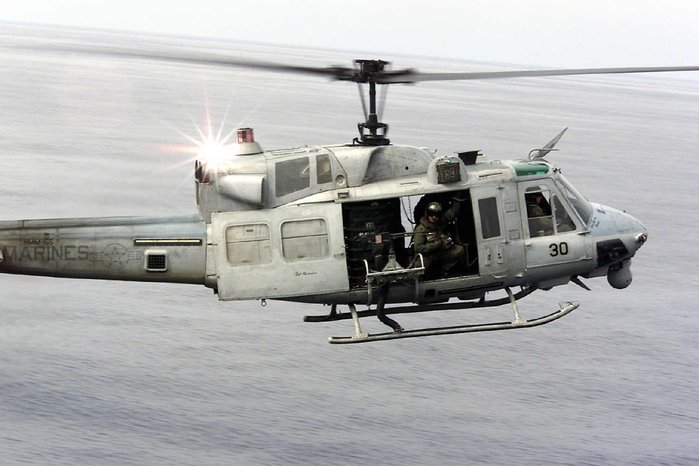
UH-1 시리즈는 이후에도 지속적으로 업그레이드가 진행되면서 단발엔진 방식에서 쌍발엔진 방식의 파생형까지 등장했다. 최초의 쌍발엔진 파생형은 UH-1N 트윈 휴이(Twin Huey) 헬리콥터였으며, 이후에는 이를 바탕으로 한 UH-1Y 베놈(Venom)도 등장했다. 1N은 캐나다의 요청으로 개발된 형상으로 1968년부터 개발에 착수했으며, 기존 라이커밍 엔진이 아닌 프랫 앤 위트니(Pratt & Whitney)의 PT6T 엔진이 설치되었다. N형은 이후 미 공군도 1970년부터 주문하였으며, 1971년에는 미 해병대와 해군도 주문하여 기체를 인도받았다. 한편 1996년에는 미 해병대가 H-1 업그레이드 사업을 발주하면서 다시 한번 벨 사를 우선협상대상자로 선택했으며, 이번에는 UH-1Y와 공격헬기 형상인 AH-1Z ‘바이퍼(Viper)’를 제안했다. 1Y는 2008년부터 미 해병대에 인도가 시작됐으며, AH-1Z는 2010년부터 미 해병대에 실전 배치되기 시작했다. 특히 1Z는 바레인과 파키스탄도 계약을 체결하여 인도를 기다리고 있는 상태다.
- UH-1은 발전을 계속하여 쌍발엔진을 장착한 UH-1N이 해병대에 도입되었다. (출처: 미 해군)
특징
기본적인 UH-1 형상은 반(半) 모노코크(Monocoque) 구조의 동체에 스키 형태의 이착륙용 스키드(skid)가 장착되고, 주익(主翼) 로터로 두 장의 날개가 붙어있는 형태이다. 초기형 UH-1에는 라이커밍사의 700마력 T53 터보샤프트 엔진이 장착됐으나 이는 단계적으로 업그레이드가 되면서 최대 1,400마력까지 증가했으며, 트윈 휴이를 비롯한 일부 UH-1 후기 형상에는 엔진 두 기와 네 장의 주익 로터가 장착되는 파생형까지 등장했다.
- UH-1은 세미 모노코크 동체에 로터가 2엽 장착되는 형상이다. (출처: 미 공군)

UH-1은 단발엔진 방식의 모델 204와 205, 그리고 쌍발엔진의 모델 212와 412가 가장 많이 양산되었다. 실제로는 네 형상이 모두 동일한 기본 설계에 바탕하고 있지만 내부 설계나 관리 체계 상에서 상이한 부분이 많아 실제로는 두 개의 별개 항공기로 분류한다. 204형의 파생형은 UH-1A, B, C, E, F, K, L, M, P가 있으며, 205는 UH-1D, H, U, V, X형, 그리고 쌍발식 212는 UH-1N으로 나뉜다. 412모델은 사실 212 모델과 유사하나 주익 로터가 2엽이 아닌 4엽식인 점이 가장 큰 차이점이다. 모델 412는 UH-1Y로 제식 번호가 지정되었다. UH-1 시리즈 중 가장 많이 양산된 형상은 전 세계에서 5,000대 가까이 양산된 UH-1H이다.
- UH-1의 파워트레인은 동체 후방 상부에 수납된다. (출처: ninetalis.com)
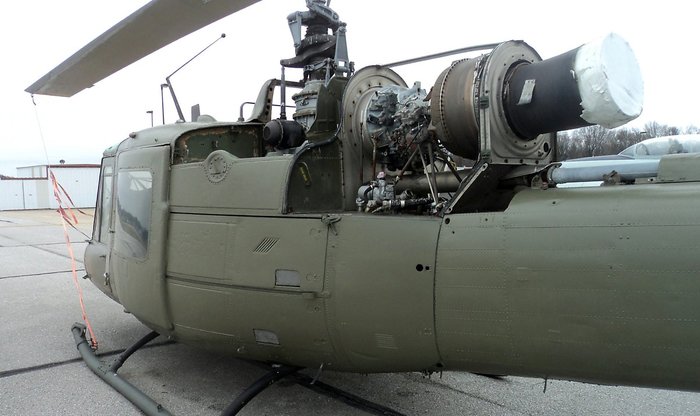
UH-1의 동체 안에는 엔진, 트랜스미션, 로터 마스트(rotor mast), 주익 로터 날개, 미익 로터 드라이브 샤프트(drive shaft), 그리고 42도/90도 기어박스가 장착되어 있다. 트럔스미션은 주익 로터 회전 수를 분당 324회로 유지시키는 역할을 하며, 두 장의 주익 날개가 채택되어 있기 때문에 날개를 한 방향으로 모아 접을 경우 헬기의 수납 공간을 줄일 수 있으나 대신 동체의 잔 진동은 커진다는 단점이 있다. 또한 두 장의 날개 때문에 기체의 하강이나 회전 때 특유의 순간적인 강한 진동이 발생하기도 한다.
- UH-1 측면의 슬라이딩식 도어와 측면을 보게 설치한 좌석들의 모습. 도어는 필요에 따라 제거가 가능하다. (출처: Adam Hartman, US Strategic Command)
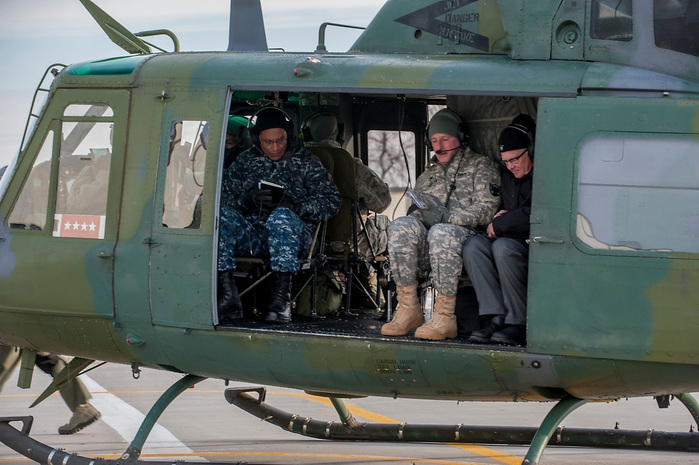
내부 좌석은 두 개의 조종석 좌석과 승객석으로 13개가 캐빈 공간에 설치되어 있으며, 최대한으로 탑승자를 늘릴 경우 조종석 바로 뒤에 4개의 역방향 좌석, 이와 마주 보는 순방향 5개 좌석을 설치한 후 항공기 양 측면 방향에 각각 한 개의 좌석을 더 추가할 수 있다. UH-1의 전 좌석은 알루미늄 철골 위에 캔버스(canvas)를 씌운 형태이며, 설치와 제거가 간편하여 필요에 따라 좌석을 제거하고 들것 등을 집어넣을 공간을 확보할 수 있다. 들것을 넣을 경우 총 6개의 들것을 캐빈 공간에 넣는 것이 가능하다. 그 외에도 구조용 호이스트(hoist), 외부 연료탱크, 스포트라이트 등 의무후송 임무에 필요한 장비류도 함께 수납할 수 있다. 뒷문 두 개는 슬라이드 방식으로 설치되어 있으나 그 앞에는 힌지(hinge) 방식의 패널이 걸려있어 필요에 따라서는 이를 떼버리고 문이 없는 상태로 비행이 가능하다.
- 일본 시즈오카현에서 신-토메이 고속도로 상공을 비행 중인 미 공군 제374 작전단 소속 UH-1N의 내부 모습. (출처: US Air Force/Osakabe Yasuo/Released)
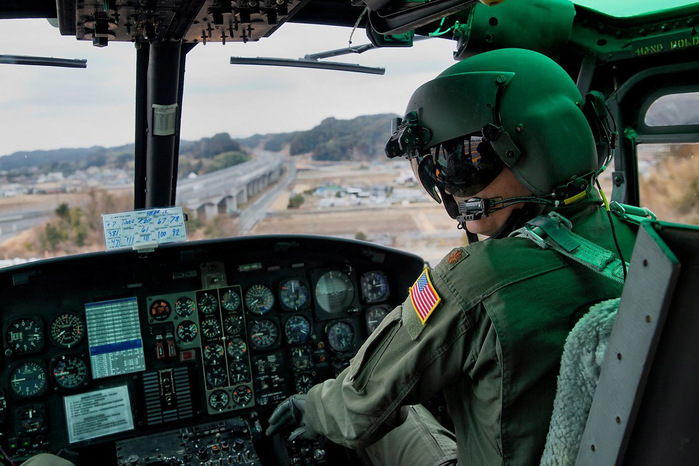
조종석은 가장 통상적인 헬기 조종 방식으로 구성되어 있어 좌석에는 로터의 스워시플레이트(swashplate) 회전축을 움직이는 조종 스틱, 헬기 속도를 통제하는 레버, 그리고 반(反) 토크(torque) 페달이 설치되어 있다. 레버는 스로틀(throttle)이 일체형으로 들어가 있으나 이것으로 메인 로터의 회전 속도를 통제하는 것이 아니라 엔진 출력을 조종하게 된다. 메인 로터의 회전 속도는 자동으로 통제된다. 조종석에는 기본적으로 장갑이 설치되어 있지 않으므로 기본적인 방호가 되어 있지는 않으나, 주문 사양에 따라서는 좌석 주변에 방탄판 처리를 해서 출고된 경우도 있다.
- 요코스카 기지에서 정비 중인 UH-1N의 내부 모습. (출처: US Air Force/Osakabe Yasuo/Released)
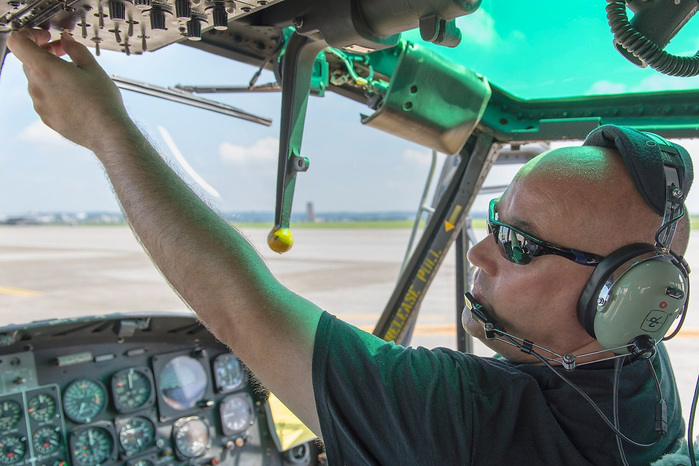
휴이 동체 내에는 다섯 개의 연료탱크가 분산되어 장착되어 있으나 하나로 연동되어 작동하며, 그중 세 개는 변속 장치 뒤에, 나머지 둘은 캐빈 공간 하부에 설치되어 있다. 다섯 개의 연료탱크는 모두 자동 밀봉식으로 설계되어 있다. 기본적으로 이착륙을 위해서 스키드가 동체 아래에 장착되어 있으나, 필요에 따라서는 물 위에 뜰 수 있도록 부력식 공기 튜브를 설치할 수도 있다.
- 요코스카 기지에서 정비 중인 UH-1N의 내부 모습. (출처: US Air Force/Osakabe Yasuo/Released)
운용 현황
UH-1 시리즈는 1960년대부터 냉전 시기까지 활약했으며, 특히 베트남 전쟁에서 팔방미인의 면모를 과시하며 미군의 아이콘으로 자리 잡았다. 특히 수송, 수색 구조, 근접항공지원, 공정 강습, 인도적 구호까지 광범위한 임무를 소화하면서 향후 헬리콥터의 활용 범위와 폭을 크게 개척했다고 해도 과언이 아니다.
- 베트남 전쟁에 투입됐던 UH-1 헬리콥터의 모습. (출처: File Photo/US Army)
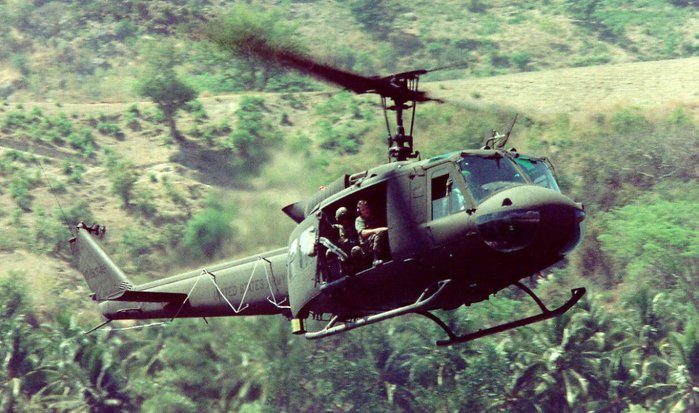
UH-1 헬리콥터는 다목적으로 운용되며 지휘 통신, 의무 후송, 병력/장비/물자 수송용으로 폭넓게 활용되었으며, 미군은 1959년부터 초도 물량을 도입하여 운용하기 시작했다. UH-1 시리즈의 초도 기체들은 켄터키주 포트 캠벨(Fort Campbell, KY)의 미 제101공정사단(현재의 101공중강습사단)과 미 제82공정사단, 제57의무파견대에 배치됐다. 사실 이들 물량은 시험평가용으로 배치된 것이었으나 순식간에 헬기의 유용성이 입증되면서 실전 배치에 들어갔으며, 제57의무파견대는 1962년 3월 UH-1A 헬기를 타고 베트남에 전개됐다. 이후 베트남 전쟁의 상징처럼 변한 UH-1은 일반 지원, 공중 강습, 물자 수송, 의무 후송, 수색 구조, 전자전, 지상 공격 임무까지 모두 소화했다. 이로쿼이는 베트남 전쟁 개전 시기부터 16년간 16,000대의 헬기가 양산되어 그중 7,000대 이상이 베트남에 전개됐다. 특히 미 육군의 이로쿼이 활용을 보면서 타 군까지 UH-1 시리즈를 도입했기 때문에 UH-1의 활약 범위도 크게 확장됐다.
- (출처: Public Domain)
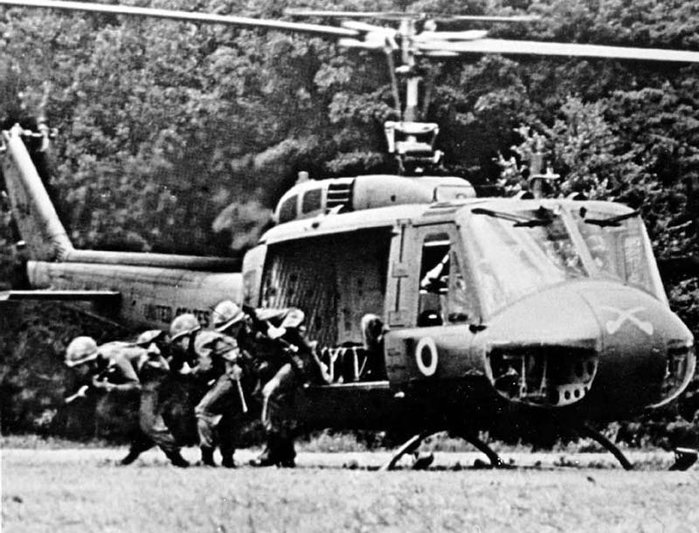
이로쿼이 헬리콥터가 전술적 혁명을 가져온 부분은 이착륙이 간편한 헬기를 이용하여 다수의 병력을 순식간에 한 지점으로 집결할 수 있게 한 ‘급속 병력 집중 ’ 개념이었다. 이로쿼이의 등장과 함께 항공 자산을 활용한 병력 집중의 개념이 등장하면서 보병의 운용 및 전개 방식 자체가 영원히 바뀌어 버렸으며, 이는 ‘공중기동(air mobile)’이라는 운용 개념으로 부르게 되었다. 베트남 전쟁을 통해 다듬어진 이 개념은 이후 1983년 10월 그레나다(Grenada) 침공 때에도 활용되었고, 제한적이나마 1991년 걸프전쟁 때에도 등장하였다. 휴이는 걸프전쟁을 기점으로 수명 한도와 능력 한계에 따라 서서히 도태되기 시작했으며, 2006년이 됐을 무렵에는 대다수의 기체가 UH-60과 교대한 후 주 방위군으로 전환되었다. 아직까지 미 육군이 보유 중인 기체는 육군 시험평가본부에서 운용 중인 11대 가량의 기체뿐이며, 이들은 각각 레드스톤 무기고(3대), 유마 시험사격장(4대), 화이트 샌즈 미사일 시험장(4대)에 흩어져 운용 중이다.
- 마지막 비행을 마친 미 육군의 마지막 UH-1 휴이 (출처: 미 육군)
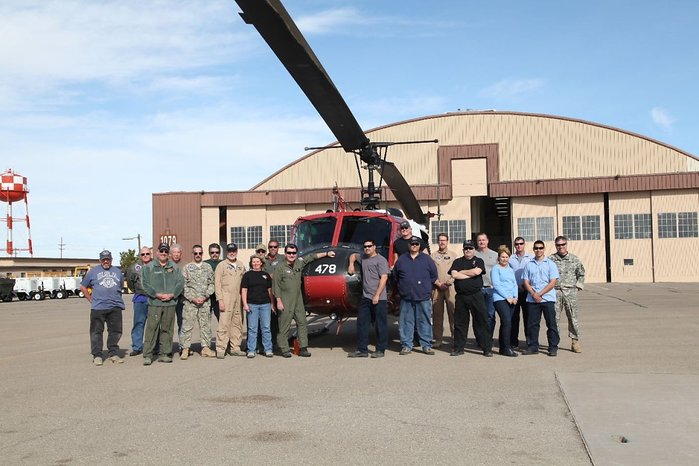
기체 번호 74-22478번이던 미군 육군의 마지막 UH-1 휴이(Huey) 헬리콥터는 2016년 12월 15일 자로 퇴역했다. 74-22478번기는 마지막 비행으로 뉴멕시코주 남부 지역을 비행한 뒤 루이지애나주 경찰로 이양되었다. 해당 기체는 1976년 초 미 육군 납품을 위해 양산됐던 마지막 기체였으며, 미군 병사들과 함께 42년 동안 함께 해 왔다. 루이지애나 경찰은 해당 기체를 한동안 주력 기체로 활용할 예정이므로 아직 휴이의 여정은 끝나지 않았다. UH-1 이로쿼이 헬리콥터는 1960년대 미군 최초의 터빈 동력 방식 헬리콥터였으며, 혁신적인 기술의 도입으로 기존 헬기들과 차별화된 성능을 보여주어 전장 위 헬기의 역할에 일대 혁명을 일으켰다. UH-1은 베트남전쟁 간 미국의 4군(육, 해, 공, 해병)이 모두 운용했을 뿐 아니라, 해외 수출도 활발하게 이루어졌다. 특히 휴이의 안정적인 성능 덕에 4군은 병력 수송, 의무 후송, 지휘 통제, 무장 건십(gunship) 역할까지 모두 동일 플랫폼 기체에 믿고 맡길 수 있었다.
- (출처: Public Domain)
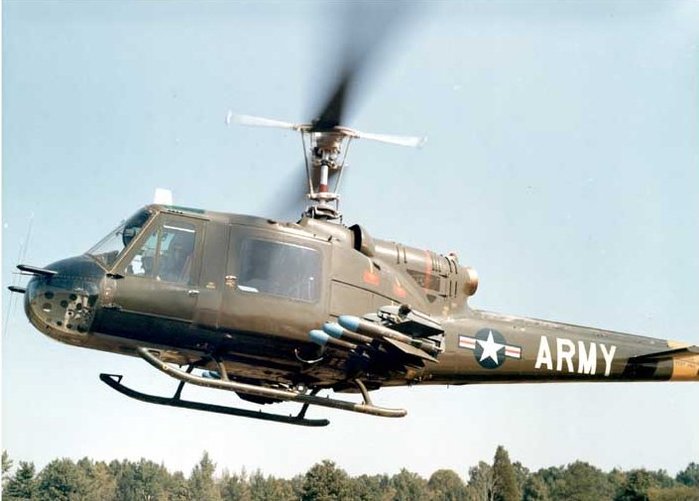
UH-1 시리즈는 다양한 파생형으로도 유명한데, 그중 UH-1B형은 처음부터 공격용으로 개발한 형상이라는 점에서 독특하다. 기본적으로 UH-1은 공격헬기 성격이 아니었으나 UH-1B형이 최초로 무장헬기로 운용되면서 BGM-71 TOW 미사일과 XM26 무장하부체계를 설치하여 1972년 부활절 공세 작전 지원에 투입됐다. 사실상 미 육군의 첫 “건십”인 UH-1B는 지상 병력에 대한 근접항공지원(CAS: Close Air Support)을 실시할 목적으로 M60 중기관총이나 TOW 미사일을 장착했다. UH-1B에는 M134 개틀링 기관총이 장착되었으며, 기총좌는 캐빈 도어 양측에 설치되었다. 이 기총 사수들은 전신을 기체 밖으로 내놓고 있었기 때문에 이착륙 등 취약한 순간에 공격 당하는 경우가 있어 가슴에 일명 “치킨 플레이트(chicken Plate)”라 부른 방어 장비를 지급했지만, 대다수의 기총 사수가 걱정한 것은 흉부로 날아오는 적의 총탄보다는 아래에서 위를 향해 쏘는 적 총알이 동체 하부와 의자를 뚫고 올라오는 경우였으므로 대부분 방어 장비를 벗어 깔고 앉는 쪽을 택했다.
- (출처: Public Domain)

첫 형상인 UH-1A와 B는 사실 출력이 약해 미 육군에서 불만이 많은 편이었다. 사실 터보 샤프트 엔진을 장착한 UH-1A/B의 출력은 기존 헬기에 비한다면 절대로 낮은 편이 아니었으나, 베트남의 뜨거운 기후와 산악 지형에서는 버거운 성능을 보였기 때문에 엔진의 교체가 필요했다. 결국 UH-1C형부터는 150마력이 증가한 엔진으로 교체되었고, 1D형은 동체와 로터까지 크게 변경하면서 엔진 출력까지 100마력을 추가로 더했다. 사실 헬리콥터에게 있어 베트남의 환경은 혹독한 편이었으므로 휴이의 설계 문제나 성능 문제와는 무관하다고 볼 수 있다. 하지만 특히 더운 열기는 기기 계통에 무리를 주었으므로 UH-1 시리즈가 최대 탑승 인원을 전부 싣고 비행하는 경우는 매우 드물었다.
- 미 공군 UH-1N을 이용하여 요코스카 미 해군 병원으로 환자를 이송하는 ‘에어 앰뷸런스’ 개념을 연습 중인 미 해군 장병들의 모습. (출처: US Navy/Mass Communication Specialist 2nd Class Josh Curtis/Released)
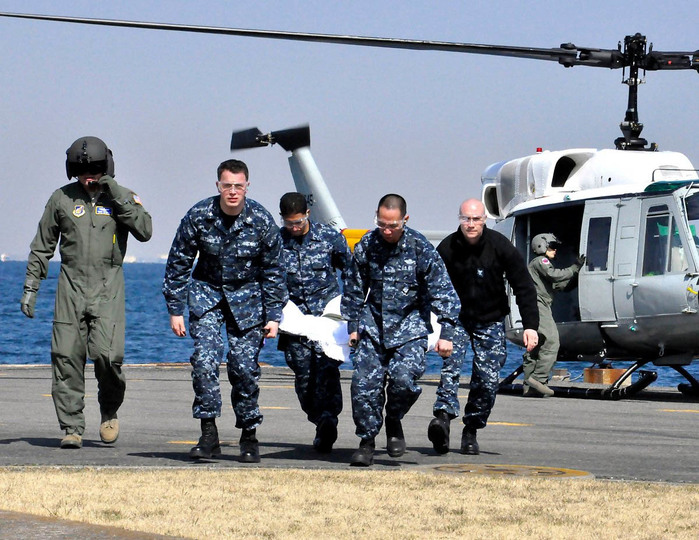
후기 기종에 속하는 모델 212는 UH-1N으로 지정되었으며, 초도 물량 50대는 캐나다에서 주문했으나 곧이어 미군도 대량의 N형 모델을 도입했다. 미군의 UH-1N은 1970년부터 실전에 배치되었으며, 캐나다군의 동일 형상인 CUH-1N은 1971년부터 실전 배치되었다. N형은 UH-1H에 비해 동체 크기가 커진 것이 특징이며, 메인 로터 지름도 소폭 늘어났다. N 형상은 미 공군이 1970년에 도입하면서 처음 실전 배치되었으며, 주로 수색 구조 용도로 운용되었다. 특히 N형은 쌍발엔진 덕에 안정성이 높았으므로 귀빈 호송이나 미사일 엄호 용도로도 폭넓게 운용됐다. 미 공군은 2018년 9월 UH-1N의 대체 기종 도입 사업을 진행하여 록히드-마틴(Lockheed-Martin) 및 시에라-네바다(Sierra-Nevada)를 탈락시키고 이탈리아 레오나르도(Leonardo)의 AW-139 헬리콥터의 군용 형상인 MH-139를 선택했다. 현재 UH-1N형은 MH-139 그레이 울프(Grey Wolf) 헬리콥터와 교체 중이며, 미 공군은 첫 기체를 2019년 12월 19일 플로리다주 듀크(Duke) 기지에서 수령했다.
- 미 공군 UH-1N을 이용하여 요코스카 미 해군 병원으로 환자를 이송하는 ‘에어 앰뷸런스’ 개념을 연습 중인 미 해군 장병들의 모습. (출처: US Navy/Mass Communication Specialist 2nd Class Josh Curtis/Released)
UH-1 시리즈는 해외 수출도 활발하게 이루어진 기체로, 세계 각지에서 총 35개국이 도입하여 운용했다. 아르헨티나 육군 항공대는 총 9대의 UH-1H를 도입하여 포클랜드 전쟁에서 운용했으며, 주로 포트 스탠리(Port Stanley; 아르헨티나 측 명칭은 푸에르토 아르젠티노 기지)에서 수색 구조 임무 및 수송 임무를 소화했다. 하지만 두 대는 영국군에게 격추당하고 일곱 대는 영국군에게 나포 당해 전후 영국과 포클랜드 섬에 전시되었다.
- 대한민국도 UH-1의 주요운용국으로 현재 수리온으로 교체중에 있다. (출처: 국방부)

왕립 오스트레일리아 공군은 1989년까지 UH-1H형을 운용했으며, 1960년대 중반 베트남 전쟁에 참전하면서 제1 오스트레일리아 특수임무부대(TF)와 함께 전장에 전개되었다. 오스트레일리아 공군은 주로 근접항공지원 및 병력 수송, 의무 후송 용도로 활용했으며, 일부 기체는 완전 무장시켜 건십 용도로도 활용했다. 호주는 1982년부터 1986년까지 이집트 시나이반도에 UN 평화유지군으로 전개되면서 UH-1을 함께 운용했으나, 1980년대 말부터 S-70A 블랙호크(Blackhawk)와 단계적으로 교체를 실시했다.
- 호주군은 UH-1H를 운용하다가 1980년대말부터 UH-60으로 교체를 시작했다. (출처: Public Domain)
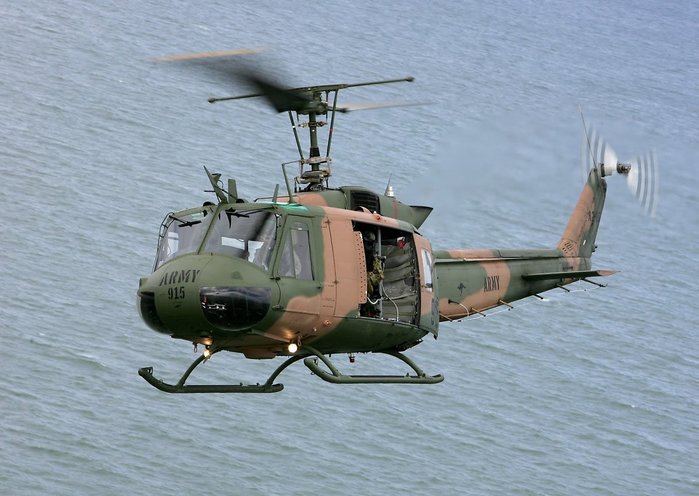
또 하나의 장기 운용 국가는 이스라엘로, 70년대 초부터 운용을 시작하여 2002년까지 운용하다가 1994년부터 UH-60과 교체시켰다. 이스라엘은 UH-1 퇴역 후 레바논 내의 친 이스라엘계 군사 조직에 이양했으며, 11대의 UH-1D형은 싱가포르의 한 기업에 판매했으나 이들 기업은 실제로는 1978년에 로디지아 공군에 해당 기체를 모두 넘겼다. 이는 로디지아 부시(Bush) 전쟁 때문에 당시 UN에서 내린 금수 제재를 회피하기 위한 조치였던 것으로 보인다.
- 이스라엘도 UH-1을 집중적으로 운용하다가 UH-60으로 전환했다. (출처: Public Domain)
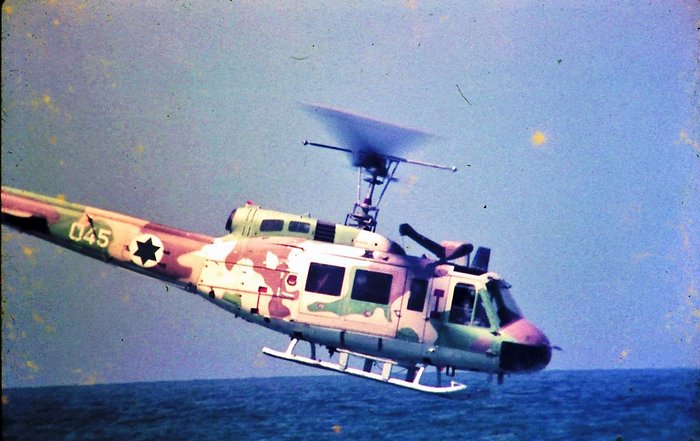
일본 육상자위대 역시 UH-1을 오랫동안 운용해왔으며, 현재까지도 일부 기체가 계속 운용 중에 있다. 비교적 최근에 운용된 사례는 2011년 도호쿠 쓰나미 때 인도적 구호 작전을 위해 전개됐을 때였으며, 당시 자위대의 UH-1은 후쿠시마 제1 원자력발전소(福島第一原子力発電所) 피해 평가를 위해 상공 정찰을 실시했었다. 주로 미군으로부터 중고 기체를 공여 받아온 필리핀은 미 공군 퇴역 물자였던 UH-1을 수령했으며, 프란시스 포드 코폴라(Francis Ford Coppola, 1939~) 감독이 <지옥의 묵시록(Apocalypse Now, 1979)>을 촬영할 당시 필리핀 독재자였던 페르디난드 마르코스(Ferdinand Marcos, 1917~1989)의 지원으로 필리핀 공군의 휴이 헬리콥터를 받아 영화 촬영을 마치기도 했다. 필리핀 공군은 2013년에도 21대의 UH-1H를 추가로 도입한 바 있다.
- 2019년 6월 21일 타치가와 기지에 불시착한 UH-1J (출처: defence-blog.com)
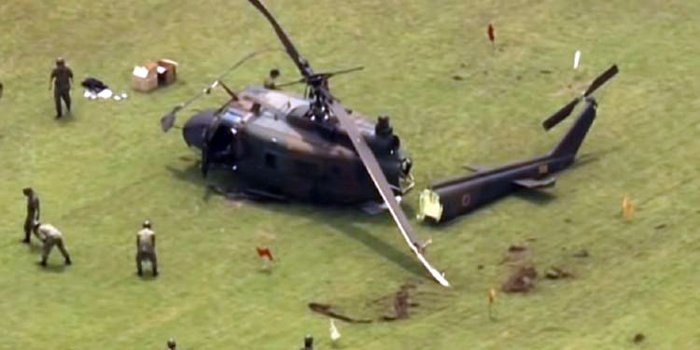
UH-1 시리즈는 조종사들에게 폭넓은 사랑을 받은 기종으로, 견고한 설계와 폭넓은 적응 능력, 그리고 비교적 복잡하지 않은 운용 유지 때문이었다. 휴이 파일럿 출신인 리처드 젤러슨(Richard Jellerson)은 휴이 헬리콥터를 헬기에 비견하면서 “수리가 단순했고, 적의 공격을 얼마를 받든 상관없었다. 일부 기체는 엄청나게 많은 총알 구멍과 함께 귀환했는데, 그런 상태의 기체가 어떻게 날 수가 있었는지 믿기 힘들 정도였다.”라고 남겼다. UH-1H는 9·11 테러 이후에도 미 마약단속국(DEA: Drug Enforcement Administration)이 아프가니스탄에서 운용했으며, 이들 휴이 헬기는 DEA 야전부대인 FAST팀에 대한 항공 지원을 제공하는 역할을 실시했다.
- 미 정부기관에서는 육군이 도태시킨 UH-1H를 운용중이다. 사진은 국무부 소속 기체이다.
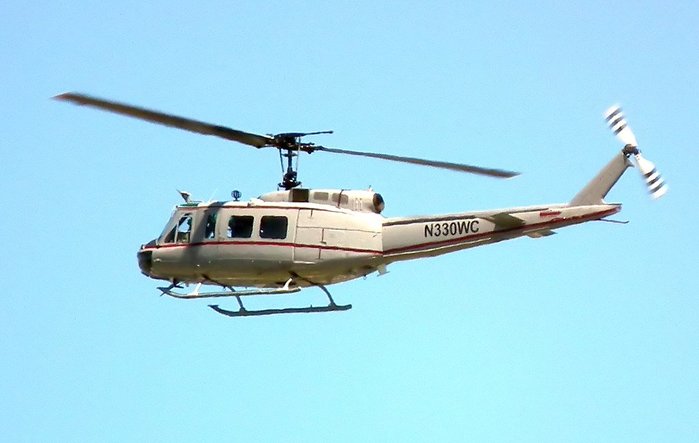
제원
UH-1D형
종류: 다목적 헬리콥터
제조사: 벨(Bell) 헬리콥터
승무원: 1~4명
탑승 가능 인원: 13명
전장: 17.4m (로터 포함)
전고: 4.39m
전폭: 2.62m (동체)
로터 지름: 14.63m
자체 중량: 2,365kg
총중량: 4,100kg
최대 이륙 중량: 4,309kg
적재 중량: 1,760kg (병력 14명 혹은 들 것 6개, 혹은 동일 중량의 물자)
추진체계: 1,100마력(820kW)급 라이커밍 T53-L-11 터보샤프트 엔진 x 1
최고 속도: 220km/h
순항 속도: 205km/h
항속 거리: 510km
실용 상승 한도: 5,910m
상승률: 8.9m/s
출력 대비 중량: 0.25 kW/kg
무장: 형상에 따라 다름
ㄴ 7.62mm 다목적 기관총 x 2 (도어 설치식, M60 혹은 MG3)
ㄴ 7.62mm GUA-17/A 미니건 x 2 (도어 설치식 혹은 외부 장착)
ㄴ Mk.44 / Mk. 46/ MQ. 44 어뢰 x 2
ㄴ AS.12 공대지 미사일 x 2
ㄴ “시 킬러(Sea Killer)” 공대함 미사일 x 2
ㄴ 7연장 2.75인치 로켓 포드 x 2
ㄴ 19연장 2.75인치 로켓 포드 x 2
ㄴ 기타 재래식 폭탄
ㄴ BGM-71 TOW 대전차 미사일
ㄴ AGM-22/B 공대지 미사일
ㄴ 20mm M24A1 기관포
ㄴ 30mm XM140 기관포
ㄴ 12.7mm M2BH 중기관총
ㄴ 12.7mm XM213/M213 기관총
ㄴ SUU-13D/A 지뢰살포기
ㄴ 40mm M129 자동화 유탄발사기(AGL)
ㄴ XM159 2.75인치 로켓 발사기
ㄴ MA-2/A 2발식 2.75인치 로켓 발사기
ㄴ 12.7mm GAU-15A/16A/17A 미니건
ㄴ MX18/M18 미니건 포드
ㄴ 연막탄 살포기
대당 가격: 34만 5천 달러(1965년 UH-1H형 기준/1975년 수출 가격 80만 달러)
저자 소개
윤상용 | 군사 칼럼니스트

예비역 대위로 현재 한국국방안보포럼(KODEF) 연구위원으로 활동하고 있다. 미국 머서스버그 아카데미(Mercersburg Academy) 및 서강대학교 정치외교학과를 졸업했으며, 동 대학 국제대학원에서 국제관계학 석사학위를 받았다. 육군 통역사관 2기로 임관하여 육군 제3야전군사령부에서 군사령관 전속 통역장교로 근무했으며, 미 육군성에서 수여하는 육군근무유공훈장(Army Achievement Medal)을 수훈했다. 주간 경제지인 《이코노믹 리뷰》에 칼럼 ‘밀리터리 노트’를 연재 중이며, 역서로는 『명장의 코드』, 『영화 속의 국제정치』(공역), 『아메리칸 스나이퍼』(공역), 『이런 전쟁』(공역)이 있다.
Máy Bay B52 Của Việt Nam Khiến Quân Polpot Khiếp Đảm Như Thế Nào?
Máy Bay B52 Của Việt Nam Khiến Quân Polpot Khiếp Đảm Như Thế Nào?
Cảm ơn các bạn đã xem video!
Nếu thấy hay các bạn nhớ ủng hộ kệnh bằng cách like, comment và share, đừng quên đăng ký kênh để xem những video hấp dẫn tiếp theo nhé!
Biên tập nội dung \u0026 MC:
Dựng video:
Giọng Đọc:
✅ Liên Hệ Quảng Cáo:
+ SĐT: 0355141222
+ Email: [email protected]
Music by: https://www.youtube.com/audiolibrary/…
Photos Licensed Under CC
Copyright Disclaimer
Chúng tôi không sở hữu hoàn toàn những tư liệu được tổng hợp trong video này. Nó thuộc về những cá nhân hay tổ chức đáng được tôn trọng.
Chúng tôi sử dụng theo: Tuyên bố từ chối trách nhiệm bản quyền mục 107 của Đạo luật bản quyền năm 1976. Được phép \”sử dụng hợp lý\” cho các mục đích như phê bình, bình luận, báo cáo tin tức, giảng dạy, học bổng và nghiên cứu.
We does not own the rights to these video clips. They have, in accordance with fair use, been repurposed with the intent of educating and inspiring others. However, if any content owners would like their images removed, please contact us by
nguocdonglichsu lichsuvietnam lichsu damdaolichsu
นอกจากการดูบทความนี้แล้ว คุณยังสามารถดูข้อมูลที่เป็นประโยชน์อื่นๆ อีกมากมายที่เราให้ไว้ที่นี่: ดูความรู้เพิ่มเติมที่นี่

Đế Vương Dunghoangpham Remix ✈ Một Bậc Quân Vương Remix ✈ Remix 2021 Tiktok Nonstop mới nhất
Đế Vương Dunghoangpham Remix ✈ Một Bậc Quân Vương Remix ✈ Remix 2021 Tiktok Nonstop mới nhất
nhactreremix
devuong
dunghoangpham
vinahouse
fuhoremix
TRACKLIST
01. Đế Vương Ver.3 Dunghoangpham x Đình Dũng
02. Áo cũ tình em Thương Võ
03. Xem Như Em Chẳng May Chu Thuý Quỳnh ft Trung Ngon
04. Biết Tìm Đâu Ver.2 Dunghoangpham x Duy Mạnh
05. Ngỡ Như Giấc Mơ Chu Duyên
06. Thì Thôi Ver.3 TVk x Nal
07. Người Thương Em Cả Đời Em Xua Đuổi Ver.3 Như Việt
08. Đào Nương Hoàng Vương
09. Sao Ta Ngược Lối Đình Dũng | Thương Võ Cover
10. Tấm Thân Dãi Dầu Ver.2 PHÁT HUY T4
11. Hạnh Phúc Thoáng Qua Dunghoangpham x Nguyễn Đình Vũ
12. Như Một Người Dưng Nguyễn Thạc Bảo Ngọc
13. Em Là Con Thuyền Cô Đơn Thái Học
14. Người Lạ Từng Thương Ver 2 Như Việt
15. Lựa Chọn Của Anh Thương Võ
16. Tình Yêu Ngủ Quên Ver.2 Hoàng Tôn ft LyHan
17. Bỏ Lỡ Một Người Bỏ Lỡ Một Đời Ver.2 Châu Khải Phong ft Lê Chí Trung
18. MỆT CHƯA? ANH VỀ ĐÂY HANA CẨM TIÊN
19. Tiếng Tơ Lòng HKRAY x TRUZG
20. Vách Ngọc Ngà Ver. 2 Anh Rồng
● Đừng quên Đăng ký (Subscribe) Fuho Remix để cập nhật những bản nhạc hot nhất mới nhất hiện nay nhé!
● Fuho Remix là một đối tác chiến lược của Công ty TNHH ACV Entertainment
Mọi vấn đề bản quyền xin vui lòng liên hệ: [email protected]
©CZ Media \u0026 ACV Entertainment
Tag : nhac tre remix,lk nhac tre remix,nhac tre remix 2021,nhac remix,htrol remix,nhac remix 2021,nhạc trẻ remix,nhac tre,nhạc remix,lk nhạc trẻ remix,nhac tre remix hay nhất,bxh nhạc trẻ remix,nhạc trẻ remix 2021,orinn remix,nhạc remix 2021,nhac edm,nhac tre 2021,top edm remix,edm remix,remix,nhạc trẻ edm,nhạc remix mới,nhạc edm,edm remix 2021,remix edm acv remix,remix,nhac tre remix,viet mix,nhac tre remix 2021,remix 2021,acv,hanh phuc cuoi cung acv remix,hanh phuc cuoi cung remix,việt mix,nhac tre remix 2021 moi nhat,nhac tre remix 2021 hay nhat,nhạc trẻ remix,remix 2021 hay nhat,remix 2021 moi nhat,nhạc trẻ remix 2021,nhac tre remix 2021 hay nhat hien nay,nhac tre remix 2021 moi nhat hien nay,anh mat em xua tan man dem remix,nhac tre remix 2021 mới nhất

UH-1H Huey startup and flyby

GTA SA. Bell UH-1N Twin Huey (MOD)
MOD https://www.gtaall.com/gtasanandreas/helicopters/86719belluh1n.html
GtaSanAndreas gtamod

降下訓練始め 2016 UH-1 ハードランディング!?
平成28年 降下訓練始めでの1コマ。
追い風の影響かハードランディングしてしまったUH1。すかさずバランスを取り直し降着成功!冷やりとしましたが無事に済んで何よりでした。

นอกจากการดูบทความนี้แล้ว คุณยังสามารถดูข้อมูลที่เป็นประโยชน์อื่นๆ อีกมากมายที่เราให้ไว้ที่นี่: ดูวิธีอื่นๆWiki
ขอบคุณมากสำหรับการดูหัวข้อโพสต์ uh-1n